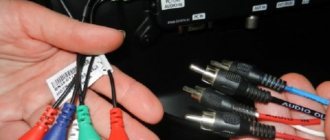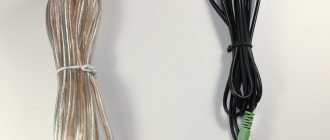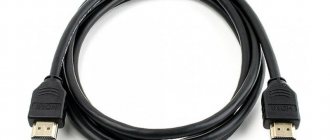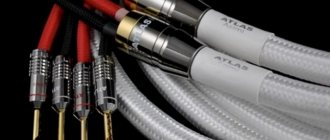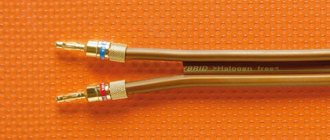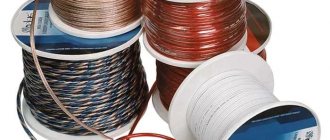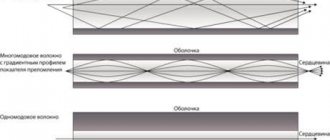Estimated reading time: 12 minute(s)
The rating of the article is not difficult for you, but it’s interesting for me. Please vote at the end of the article!
Do you like to enjoy high-quality sound? You have good speakers (maybe not even cheap ones), an excellent powerful amplifier. But the sound is somehow “not very good”, “something is wrong.” Are the wires that connect the speakers good? Thin, thick? What is the cross section of these wires? Do not know? Let's clarify a little - why is this necessary, why such questions. We will also give an example of how to calculate the cross-section of an acoustic cable for your acoustics.
Whether you listen to music at home through your good amplifier and speakers, or you have speaker systems of different power installed (such as “home theater”), or in general, you use professional systems, then in any case, it is important to use high-quality speaker cables. Yes, about them again! And also, it is necessary to create conditions for reliable and high-quality connection.
Design
Any audio wire for a home stereo or professional equipment consists of a conductive core covered with insulation, in some cases shielded, and an additional layer of outer braiding. Low-quality products often cause signal distortion or reduced power, sound deformation and the presence of extraneous noise.
There are several types of speaker cables based on their structure:
- single-core;
- stranded (bundled, symmetrical and asymmetrical, concentric, parallel and rope);
- twisted pair (with different types of shielding or without shielding at all);
- coaxial (high resistance to external interference).
What is twisted pair
When choosing a cable, you will come across the term twisted pair. These are pairs of twisted and insulated conductors. Using two insulated cords at once reduces magnetic interference and provides additional protection from mechanical or chemical damage. These cords are commercially labeled TP: Twisted Pair.
Twisted pair is used in acoustics when the length of the conductors must be significant. But be careful: there are 7 categories of these cords. Choose category 6 or 7 conductors because they are made only from copper, while other pairs can be made from copper-plated aluminum or steel. Pure copper increases the cost of acoustics, but it pays off in purity of sound.
Cables of this type can be single-core or multi-core. This affects the sound: the farther the conductors are spaced from each other, the less coherent the sound.
Multicore twisted pair cable category 6
Resistance and cross section
The carrying capacity of the wire is also important, which is affected by its own length, resistance and cross-section. The insufficient cross-section of the speaker wires contributes to the dissipation of some of the power and the relatively quiet sound of low frequencies. Resistance is the property of a material to resist the movement of electrons. The documentation of the amplifier or speakers (information may be located on the back wall of the devices) contains the optimal resistance value, and in accordance with this, speaker cables for speakers are selected.
The cross-section is the cut area of the conductor core, the magnitude of which determines the strength of the current directed along the conductor core. The characteristics of the low-frequency path play an important role in determining the cross section. A win-win option is to buy a conductor with a larger cross-section than indicated in the passport for the speakers and amplifier, since the greater the thickness of the conductor, the better.
Cable production
Here the range of manufacturers is much wider than in the case of connectors. In addition, as practice shows, there is a point here that not all types or brands of cables are equally good. That is, along with excellent cables, the manufacturer’s line can have either an excellent or a rather mediocre cable. The most famous manufacturers of cable products are the Japanese Canare, the German Klotz, Sommer Cable and Cordial. A lot of good things have been heard about the Belden company, founded back in 1902 by Joseph Belden in Chicago, USA. They say that all the commutation of one of the largest rolling mills in the world is carried out using Belden products.
Material
As a rule, such products are made from high-quality copper of three categories:
- TPC – technically pure variety;
- OFC – oxygen-free copper (the most common option);
As you know, the lower the conductor resistance, the better the signal. Due to the low resistance of this metal, copper is an ideal material for creating the best speaker cables for speakers, music equipment, professional and car audio systems. However, there is no significant difference in sound when using oxygen-free or monocrystalline copper, since the characteristics of these conductors appear below the sensitivity zone of the human ear.
The conductive core can be doped with different compositions:
- silver, which adds emotionality and brightness to the sound;
- tin, which smooths out high frequencies.
What is a bottleneck
The “bottleneck” metaphor, which has taken root in the terminology of the computer industry and electronics, management, psychology and other areas of human knowledge and activity, denotes an element that slows down the entire system, regardless of the quality of its components.
A speaker cable can also become a bottleneck: an incorrectly selected or low-quality cable reduces system performance and distorts the sound, since it is not able to correctly transmit frequencies emanating from the amplifier.
So, what characteristics of a conductor should you consider when choosing?
How to calculate the cross-section of an acoustic cable
On the Internet you can find many opinions and disputes that the sound quality is affected by the material of the braiding and insulation, the twist pitch, the purity of the copper crystals, or even the number of strands in the wire. In fact, the quality of speaker wires depends on three factors:
- cross section;
- conductive core material;
- properties of the insulating coating.
Home acoustics are most often connected via a multi-core cable. To understand how to choose the cross-section of speaker cable for speakers, you will need to make some calculations. The first step is to determine the voltage in the circuit - multiply the peak power of the amplifier by the resistance, after which we take the square root of the resulting product. Next, you should determine the current by dividing the amplifier power by the voltage resistance. It is known that a wire with a cross-section of 1.5 square millimeters can withstand a current of up to 15 amperes.
It is much easier to calculate the cross section using the table below.
Thickness matters!
So what thickness should you choose for connecting acoustics? If we don’t ask ourselves about the quality of copper, then let’s take into consideration only the length and cross-section. In what follows I will say “acoustic wire,” but mean a simple wire (electrical). For many music lovers, and even more so audiophiles, this is a very important point. But let's not discuss brands even of electrical wires. We have already touched on this topic.
Speaker wire length
Each speaker will have its own wire, its own length, since everyone has different rooms where they are supposed to listen to music. And the length should be selected so that the wire is exactly enough for connection, or at a convenient place for laying it, so that you don’t trip over the wire later, so that it would be convenient to clean the room.
But remember that the longer the wire, the thicker it should be. Purely from school physics, so that “more electrons rush through the wire per unit of time.” The larger the size of the acoustics, I assume, the more powerful the speakers will be and they will require a lot of energy. Only then will the speakers be able to deliver their full potential.
Let’s imagine that the speakers (let’s assume their height is 1.2 meters) stand three meters from each other, and in the middle there is equipment that will “rock” the acoustics. Then, for connection you will need 2-2.5 meters of wire for each speaker. We leave approximately half a meter for connection to the terminals, since they are often located higher than 30 centimeters from the floor. And another half meter for connecting to the amplifier terminals.
But this is all approximately! This is approximately what it will turn out to be, well, maybe even a little less. But it is clear that making a coil of wire under the equipment rack from “extra” wire is absolutely not worth it.
Speaker wire thickness
Now about the reason why this article was started – about thickness.
Let's make it simpler. Study the table below. Let's limit ourselves to a table of up to 10 meters. Further numbers will be approximately the same as when using a wire 10 meters long. But I don’t think that anyone at home intends to use a wire even 10 meters long.
| Wire cross-section (mm 2 ) | ||||||||||
| Speaker resistance, Ohm | wire length (meters) | |||||||||
| 1 | 2 | 3 | 4 | 5 | 6 | 7 | 8 | 9 | 10 | |
| 1 | 0,75 | 1,5 | 2,5 | 4,0 | 4,0 | 4,0 | 6,0 | 6,0 | 6,0 | 10 |
| 2 | 0,35 | 0,75 | 1,0 | 1,5 | 2,5 | 2,5 | 2,5 | 4,0 | 4,0 | 4,0 |
| 4 | 0,2 | 0,5 | 0,5 | 0,75 | 1,0 | 1,0 | 1,5 | 1,5 | 2,5 | 2,5 |
| 8 | 0,12 | 0,2 | 0,35 | 0,35 | 0,5 | 0,75 | 0,75 | 0,75 | 1,0 | 1,0 |
| 16 | 0,12 | 0,12 | 0,12 | 0,2 | 0,2 | 0,35 | 0,35 | 0,35 | 0,5 | 0,5 |
We compare the values indicated in the columns and look at the table. For example, my speakers indicate 8 ohms. I look at the left column, looking for my line. I look at the corresponding column - the length of the wire. My length is 4 meters. And at the intersection of the row (4 Ohms) and the column (4 meters) - the cross-section of the wire that I need is obtained - 0.35 mm 2. But somehow these numbers confuse me...
In fact, now I have my acoustics connected using PVA wire 2*1.5 mm2, in round PVC insulation, with stranded copper wires. They fit well with the terminal connectors. You will say that he is tough and too fat! But this is relative. All you have to do is lay the wire once, untwist it so that it doesn’t get pulled into rings, and it will stay like that for at least a hundred years. Rigidity does not play a special role here and does not interfere in any way.
Operating rules and selection tips
Many people don't know which speaker cable to choose. Here are some tips:
- you should choose products with special markings;
- It is important to determine the required length in advance, but it is best to buy copper wire with a reserve;
- pay attention to the type of connectors (connectors);
- products of famous brands are time-tested;
- the braid should not be sticky or sticky;
- for a home theater you will also need an optical cable;
- cheap goods do not guarantee high quality;
- The resistance of the speaker cable for speakers should not exceed 5% of the total value of the speaker.
Manufacturers suggest product users follow several simple operating rules. For example, to avoid a short circuit, polarity must be observed; it is prohibited to combine different wires, twist or bend them, or place the cable parallel to the network wiring.
It is also recommended to regularly clean the contacts and ensure that cables not in use are disconnected. Consistent connection of wires and equipment leads guarantees high-quality results. Special markings on speaker cables help you purchase the right products. For example, the positive wire has red insulation or is marked with a colored stripe, while the negative wire is usually painted black or not marked at all.
High-quality wires from reliable and world-famous manufacturers will help you enjoy beautiful and rich sound.
About the wires from the store
When we get into a store with audio equipment, we are no longer surprised by the prices and assortment, if only we had the money - for every taste and desire!
Next to the racks on which amplifiers and speakers are located, there is usually a large display case with various wires. These wires are specially designed for connection between equipment units, between acoustics and amplifiers, and for other purposes. This showcase is located nearby for a reason. Some manufacturers select and recommend certain types of wires. Sometimes, such wires come complete with Hi-Fi or Hi-End systems. But if this is not the case, then you have to select and purchase it yourself. Therefore, the question often arises - which speaker cable to choose, which interconnect cable to buy.
And here again a stupor may arise - how to choose? And why do you need to follow some unspoken advice and recommendations? There are a huge number of brands on the market, as well as completely unbranded companies that are unfairly not considered worthy. But today we don’t compare or test different brands. Let us just remind you that there is a large assortment, there is plenty to choose from.
And in terms of design, acoustic wires differ both visually and in technical characteristics. Some are needed to connect theater loudspeakers, others are needed to sound the stage itself. And there are cables that are better used at home, for connecting expensive floor-standing speaker systems. You can easily connect home theater acoustics and bookshelf speakers with other wires (cables).
Externally, acoustic wires differ both in quality (visually) and in what material the conductor itself is made of, how it is made (flat, round, twisted) and what cross-section it has. To solve problems with connecting acoustics effectively, you need to take into account: certain parameters of the low-frequency channel (the low-frequency range loves a wire with a sufficient cross-section), the output power of the acoustics (the more powerful, the thicker the wires), the cable length (the longer the length, the thicker the wire should be ), technical characteristics and type of wires. But still, the most important thing in this matter is to correctly calculate the cross-section of the speaker cable for the speakers.
Interconnect audio cables
Shielded, noise-proof interconnect (connecting) audio cables are used to connect components of professional sound systems.
AT-KM-092-5
AT-KM-093-1/AT-KM-093-10
AT-KM-094-1
AT-KM-095-1
Interconnect cables are designed to connect sound reproduction system devices to each other in order to transmit line and microphone level signals, and can be used in both high-quality broadcast equipment and professional ones.
Their design uses a high-quality microphone cable KM-02-2E-A with double shielding and reinforcement with cotton threads. A high level of protection of interconnect audio cables from interference is provided by the metal housing of the connectors and a two-layer shield consisting of a layer of foil and copper braiding. Table 2. Characteristics of interconnect cables
| Name | AT-KM-092-5 | AT-KM-093-1 | AT-KM-093-10 | AT-KM-094-1 | AT-KM-095-1 |
| Connector type | 6.35 mm male, XLR female | XLR male, XLR female | 6.35mm plug, 6.35mm plug | 6.35mm plug, XLR plug | |
| Cable length, m | 5 | 1 | 10 | 1 | |
| Cable diameter, mm | 6,35 | ||||
Professional-level speaker systems are usually equipped with Speakon and Euroblock connectors.
Speaker terminals
Speakers have one of two types of wire connectors—spring terminals and screw terminals (see illustration below). Spring clamps are very easy to work with. Simply press the clamp, insert the speaker wire, and release. A spring-loaded mechanism will hold the wire in place. Spring clamp terminals can accept bare wires and pin connectors, but not spade, banana, or double banana connectors.
Screw terminals provide a very strong connection for speaker wires. Unscrew the nut to reveal the hole used to connect the bare wires and pin connectors. The banana and double banana plugs connect directly into the hole in the center of the screw terminal stem. Spade type connectors are inserted into a screw terminal and secured with a nut.
Structure
Audio cable conductors can be made of copper and its alloys, or aluminum with an external copper coating. The number of cores is from 2 to 4. The insulation is made from high quality PVC materials, usually black. All audio wires have a highly flexible sheath.
Speaker cable structure
On the outside there is a safety screen made of copper braid. Its main purpose is to reduce the degree of influence of external electromagnetic distortions during the transmission of the main electrical signal. In this case, with the appropriate density of the outer braid, the efficiency of the protection system reaches its maximum value. There is a marking on the insulation that indicates the material of the wire and its functional characteristics.
Among the main properties for an audio wire are:
Ultimate resistivity - 5% of the total resistance of the complete system;
- Operating temperature range - from - 40 to + 60 C.
- The minimum bending radius during installation is the outer diameter of the AK.
- Construction and installation length is more than 25 m.
- Service life guarantee - more than 10 years.
Audio cable application
The best brands
Due to the fact that today there are a large number of models of speaker cables (for example, AUX wires) produced by both foreign and Russian companies on the market, it is quite difficult for users to navigate the purchasing process in such a variety. We bring to your attention a rating of the best and most popular manufacturers.
Oyaide Tunami II SP-Y V2
The market value of this cable is about 45,000 rubles per 2 meters. Copper 102SSC 5.5 mm2 is used as a conductor. For insulation, materials such as polyolefin and polyolefin polymers are used. The connector coating consists of palladium and platinum. This cable provides high-quality Soundwall-type sound.
Lavardin Model CHR 317
This cable belongs to a higher price category, but is available to almost all buyers. It costs 60,000 rubles for 3 m. The Lavardin Model CHR 317 uses Low Memory Distortion technology. The positive characteristics of the cable include the ability to operate even with a low-frequency spectrum of sound waves.
HMS Elektronik Concertato WBT0610
The cable is made of copper and contains several Hf-Litz cores (2 x 3 x 2.85 mm2). The dielectric is made of Teflon, and the shell is made of polyurethane. The inductance level is 164 nH/m, and the capacitance level is 466 pF/m. The signal grows quite quickly - in just 11.5 μs. The country of origin of this cable is Germany, so you can count on the highest quality.
Kubala-Sosna Anticipation
This cable is manufactured in the United States of America. It provides high quality sound reproduction. In addition, the manufacturer can note macrodynamic contrasts. The Kubala-Sosna Anticipation model is perfect for playing rock music.
Tellurium Q Blue Diamond Speaker
The cost of the device is relatively high - for 2 meters of cable you will have to pay more than 78,000 rubles. The internal structure of the cable consists of a stranded conductor. This element, in turn, is made of oxygen-free copper. Section size – 2 x 2.5 mm2. The dielectric function is performed by Teflon with the addition of polymer resins. Phase distortion is zero.
Qed Supremus
This multi-core cable is created using silver-plated copper with a purity of 99.999%. The cross-sectional size is 10 AWG, 6.2 mm2, and the capacitance rating is 48 pF/m. The dielectric is ceramic; in the process of its manufacture, materials such as enamel with polyurethane foam were used.
Chord Company Epic Reference Speaker
This speaker cable model is one of the most expensive in our rating. The cost of 3 meters of wire is more than 95,000 rubles. In this case, the manufacturer used 4x12 AWG silver-plated copper as a conductor, and PTFE Teflon serves as a dielectric.
Thanks to the wide variety of manufacturers and models of audio cables, each person will be able to choose the option that will suit their individual needs.
Euroblock connectors
| European Terminal Block - Used to carry line level, microphone level, and control signals such as RS-485 and RS-232. In Euroblock type connectors, the cable conductor is fixed with a screw, and reliable contact with any type of connecting cable is ensured, which is convenient and practical. In the designs of some models of amplifiers and Inter-M speakers, Euroblock connectors often duplicate connectors of other types. |
Effect of copper purity on the audio signal
According to GOST 859-2001, copper with a purity of more than 99% is used for the manufacture of cables, in which the maximum percentage of impurities in the worst case does not exceed 1%, which practically does not affect its conductivity.
Table of purity of electrical copper grades Copper grade M00M0M0bM1M1rM2M2rM3M3rM4
| Copper content,% | 99,99 | 99,95 | 99,97 | 99.00 | 99.00 | 99,70 | 99,70 | 99,50 | 99,50 | 99.00 |
The oxygen present in copper has a tube effect, it works like a diode, rectifying the sine wave. In oxygen-free copper of grade M0, the amount of oxygen does not exceed 0.001%. In the deoxidized M1 grade it is 0.01%, which theoretically can introduce nonlinear distortions into the audio signal no more than this value.
In practice, the introduced distortion is many times less, since the diodes are deflected by pure copper. Therefore, the presence of oxygen in copper does not affect the natural sound.
For reference. Scientists V.M. Bolshov and V.I. Gukin found that the human ear does not register nonlinear distortions of less than 3%.
About the number of cores and their diameter in the wires of an acoustic cable
The number and cross-section of cores in the cable cores do not affect the sound quality. The larger the cores and the smaller their diameter, the more elastic the cable will be. The actual question is whether it is necessary to often carry the audio system and twist the cable.
Prologue
This is not a statement, but reasoning and some experience in using wires of different sections.
Let's imagine we bought a new music center. It would seem that everything at the factory should be calculated and selected “as it should be.” But this often raises doubts as to whether the engineers calculated everything correctly. Is it correct that the acoustics at this center are connected with wires approximately 0.1-0.2 mm2 thick?
But with the music center option it’s easier, because it’s not designed for sounding a disco or even just for long-term operation at maximum volume. In addition, the included cable is no more than a meter long; it is not designed for someone to place the speakers in the corners of the room.
There will indeed be an opportunity to listen loudly, but it will not be sound, but simply cacophony! What it is? In short, it is a chaotic and meaningless jumble of sounds, which many perceive as music.
For the most part, this is the quality of the amplifier itself and the speaker systems themselves such that at a sufficient volume there may no longer be any sound, but what remains is a kind of “porridge” of sounds, cacophony.
But the wires that connect the speakers also contribute to this “mess”. Their quality, like wires in particular, often leaves much to be desired. Copper-clad aluminum wires are often found. They conduct voltage and current, but when we talk about high-quality sound, in this case it’s not about those wires.
Power amplifier connectors
The types of connectors used to connect audio sources and loads to professional Inter-M amplifiers may differ from one amplifier model to another: 6.35 mm, XLR, Speakon, combo, screw terminals, Euroblock screw terminal and other. Depending on the connectors used on the amplifier, the appropriate audio interconnect cables can be selected. Table 1. Power amplifier switching connectors
| Amplifier | Type1) | Number of channels | Input connectors | Output connectors | ||||
| constructive2) | quantity | note | constructive2) | quantity | note | |||
| D-3000 | D | 2 | XLR | 2 | analog | Speakon NL4 | 2 | |
| RJ-45 | 2 | digital | ||||||
| DPA-430L | D | 4 | Euroblock, 3-pin. | 4 | Euroblock, 4-pin. | 2 | ||
| DPA-300S, DPA-600S, DPA-900S, DPA-1200S | D | 1 | Euroblock, 3-pin. | 1 | P.G.M. | screw terminals | 4 | |
| Euroblock, 8-pin. | priority | |||||||
| DPA-300D, DPA-600D | D | 2 | Euroblock, 6-pin. | 1 | P.G.M. | screw terminals | 2 | |
| Euroblock, 8-pin. | priority | |||||||
| DPA-300T | D | 3 | Euroblock, 6-pin. | 2 | P.G.M. | screw terminals | 3 | |
| Euroblock, 8-pin. | 1 | priority | ||||||
| DPA-150Q, DPA-300Q | D | 4 | Euroblock, 6-pin. | 2 | P.G.M. | screw terminals | 4 | |
| Euroblock, 8-pin. | 1 | priority | ||||||
| DPA-50E | D | 8 | Euroblock, 6-pin. | 4 | P.G.M. | Euroblock, 6-pin. | 4 | high resistance |
| 1 | priority | low resistance | ||||||
| DSA-100D, DSA-100DV | D | 2 | Euroblock, 3-pin. | 2 | Euroblock, 4-pin. | 1 | ||
| DSA-600Q | D | 4 | XLR | 4 | Speakon NL4 | 4 | ||
| Euroblock, 8-pin. | 1 | priority | ||||||
| DSA-300E | D | 8 | XLR | 8 | Speakon NL4 | 8 | ||
| L-1800, L-2400 | A | 2 | XLR plug | 2 | parallelized | Speakon NL4 | 2 | parallelized |
| combo: XLR + 6.35 mm | screw terminals | |||||||
| Q-4300 | A | 2 | XLR plug | 2 | parallelized | Speakon NL4 | 2 | parallelized |
| combo: XLR + 6.35 mm | screw terminals | |||||||
| QD-4240, QD-4480, QD-4960 | A | 4 | combo: XLR + 6.35 mm | 4 | parallelized | screw terminals | 4 | |
| R-150plus, R-300plus, R-500plus | A | 2 | XLR plug | 2 | parallelized | Speakon NL4 | 2 | parallelized |
| 6.35 mm | screw terminals | |||||||
| V-4000 | A | 2 | XLR | 2 | parallelized | Speakon NL4 | 2 | |
| 6.35 mm | screw terminals | |||||||
| V2-1000 V2-3000 | A | 2 | XLR | 2 | parallelized | Speakon NL4 | 2 | |
| 6.35 mm | screw terminals | |||||||
| V2-5000 | A | 2 | Euroblock, 3-pin. | 2 | parallelized | Speakon NL4 | 2 | |
| combo: XLR + 6.35 mm | ||||||||
| V2-2000N, V2-4000N | A | 2 | Euroblock, 3-pin. | 2 | parallelized | Speakon NL4 | 2 | |
| combo: XLR + 6.35 mm | ||||||||
1 Amplifier type: “A” - analog, “D” - digital.
2 The plug type of connector is indicated specifically in each case; in other cases, the socket type is implied.
Composite
In addition to copper, you can also find composite varieties on the market. Although they contain a high percentage of copper, there are other components as well.
So, a popular variety is the inner part of which is copper, and the outer shell is made of some kind of metal alloy.
